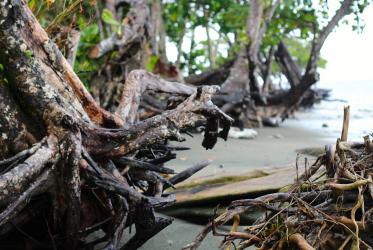Church of Melanesia
The Anglican Church came first to Melanesia in 1849 through mission efforts from New Zealand. Later on missionaries from Australia and the UK joined. At first they concentrated on New Caledonia, the New Hebrides (now Vanuatu) and the Solomon Islands. The first bishop of Melanasia was consecrated in 1861. His goal was to form a native clergy who would train and guide local lay teachers of the Christian faith. To train these catechists, a school was first set up on Mota, and later on Norfolk Island. Because of the much larger area and population of the Solomon Islands, most of the effort by the mission was soon directed towards the Solomon Islands. Missionaries worked together with local clergy to develop Christianity in Melanesia into a local expression of the one, holy, catholic and apostolic church. Since independence in the 1970s, the church has been experiencing growth in areas previously untouched by Anglicanism.
The ethos of the Church of Melanesia is catholic, with a lively liturgical worship including the daily offices and the celebration of the seven sacraments with full appeal to the five senses. The liturgies are usually in English or a local language, following ecumenical patterns, but celebrated with a local style of singing and native dancing. There are four established religious orders with about 500 brothers and sisters. The oldest is the Melanesian Brotherhood, the largest religious order in the Anglican Communion. The martyrdom by torture and death of seven brothers in 2003 brought international outcry and challenged the Church of Melanesia to go deeper into the mystery of faith. The other communities are the two international pan-Anglican orders of the Society of Saint Francis (for men) and the Community of the Sisters of the Church, and the provincial Community of the Sisters of Melanesia. The ministry of these communities encompasses thousands of lay people, encouraging a disciplined way of life through their companions, associates and third orders. The communities operate a Christian care centre for battered women and abused children in a rural area near Honiara.
The church runs several church schools, secondary and primary, and one tertiary institution where most clergy are trained. Other clergy are trained in ecumenical cooperation with the Presbyterians in Vanuatu and at diocesan training centres. Primarily for married women, the Mothers' Union in the Church of Melanesia has many young, educated women working for women's equality and rights in the church and other social spheres. The Union concentrates on the needs of developing Christian family life, literacy and hospitality programmes.
The Church of the Province of Melanesia as a whole is governed by the general convention composed of all bishops, and lay and ordained representatives from every diocese. The eight dioceses are each led by a diocesan bishop and a diocesan secretary. Each diocese is responsible for carrying out the mission of the church in its own area. Each is governed by its own synod including lay and ordained representatives. Each diocese is divided into parishes, each led by a parish priest and lay leaders. The problems faced by the Church of Melanesia in the 21st century are numerous: inflation, tremendous numbers of unemployed people, urbanization, isolation in remote communities, and the transformation of traditional Melanesian lifestyles. The tragedy of nearly five years of civil unrest and the death of many people, including members of religious communities, has sorely tested the church, but witnessing to the gospel of Jesus Christ, the Church of Melanesia goes on in the sure and certain hope of resurrection and new life in the new millennium.

